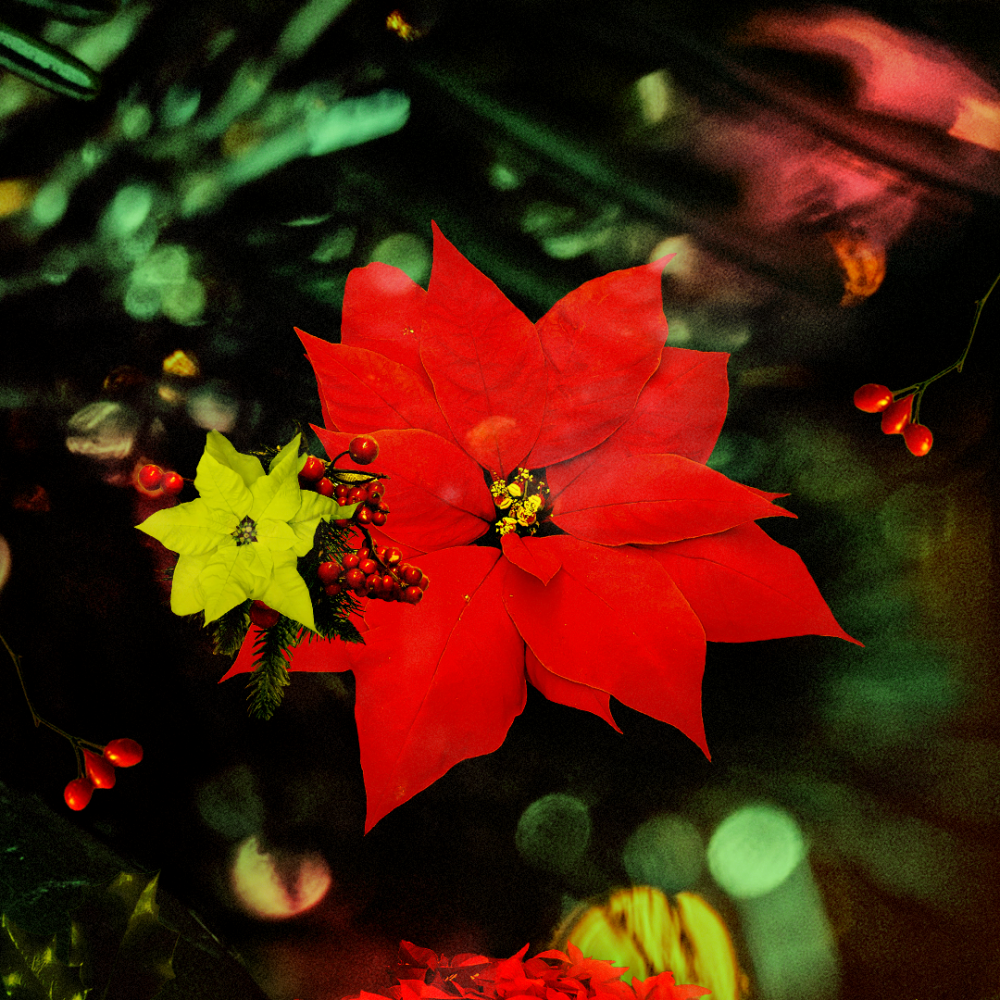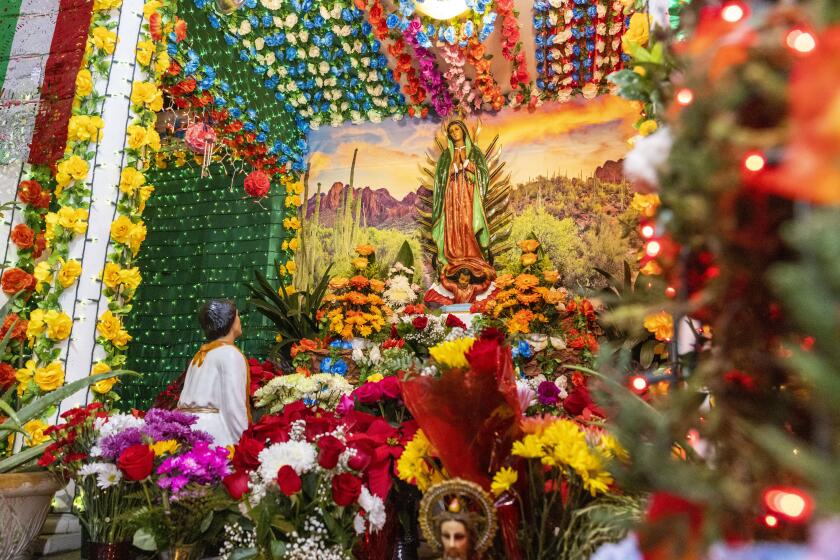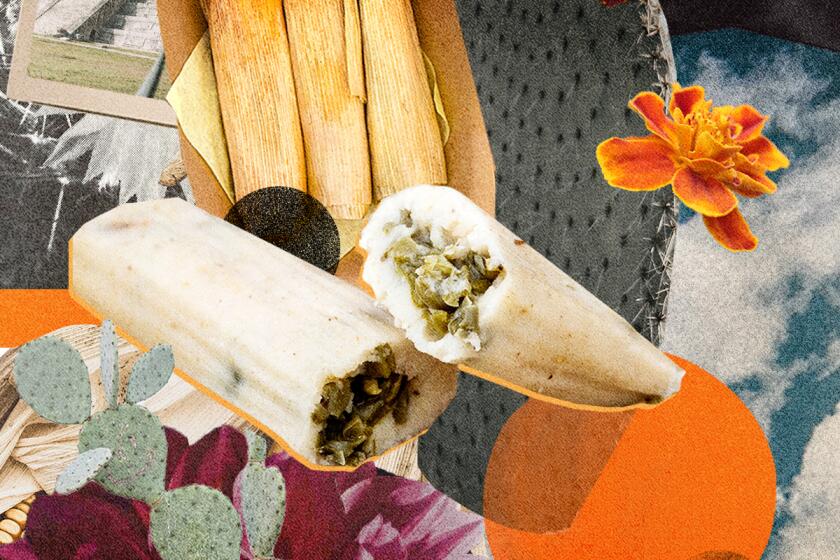
- Share via
Poinsettia plants are used to adorn stores, are printed on Christmas cards and are seen as the traditional Christmas flower. Their history begins with Indigenous communities from Latin America but is often erased according to professors and journalists.
Alexandro J. Gradilla, an associate professor of Chicana and Chicano studies at Cal State Fullerton, said that the U.S. fails to give credit to the origins of the plant and its long-standing history.
Dec. 12 marks a special day for Catholics, and for those of Mexican descent, it’s one of the most important holidays of the year.
“There is erasure and Americans don’t give any nod to Mexico or Mexicans or their herbology or their history of plants,” Gradilla said. “We just grab the poinsettia from a Home Depot or Costco and put it on our porch but we don’t ask what is the history and why is it important.”
Gradilla said that the U.S. only honors a select portion of the poinsettia history. He said that the main problem is the lack of recognition that erases generations of individuals.
In 2015, the U.S. Dept. of Agriculture reported that the poinsettia was the No. 1 potted plant in America and that throughout the country nearly 80 million sold for more than $250 million.
Currently, the poinsettia industry in the U.S. is worth around $170 million.
The U.S. has endorsed the poinsettia so much that in 2002 the House of Representatives officially declared Dec. 12 as Poinsettia Day, which in Latin America is also celebrated as a holiday honoring the Day of the Virgin of Guadalupe.
Poinsettias are native to North America, specifically areas of southwestern Mexico and Guatemala, but they are not native to the U.S. Gradilla said that by just saying poinsettias are from North America overlooks the specific cultures that cherished the plant for centuries.
For modern-day chefs who are descendants of Latin American cuisine, room exists for traditional recipes to bend and crack, opening up possibilities for something new and reflective of today’s culture.
In an op-ed for the Nebraska Examiner, Suzanna de Baca describes that as a Latina woman, knowing the history of the poinsettias has taught her about “symbolism and multi-cultural appreciation.”
“In addition to being a beloved holiday plant, the poinsettia is a reminder of how easy it is for us to appropriate the parts we love of various cultures while not always appreciating the bigger picture or valuing the people from that very culture,” she wrote.
The plant known as Euphorbia pulcherrima was introduced to the U.S. sometime after 1828. It was named after Joel Roberts Poinsett, from South Carolina, who was the first U.S. minister to Mexico. Poinsett was interested in botany and sent shrubs of the wildflower back to the U.S. He began propagating it and soon it spread throughout the country.
But before Poinsettt introduced the flowers to the U.S., they were already being used by Indigenous cultures.
“Yes, there was this man that brought the plant to the U.S., but he did not give meaning to that plant; that plant had meaning in a community beforehand and that’s what has to be rectified,” Gradilla said.
The Nahuatl name for the plant is “cuetlaxochitl” and the Mayans called it “k’alul wits.” It was used by Aztec populations as decor, for color dye and for medicinal purposes. The plant has a white milky sap that was used to treat pain in many Latin American cultures.
Learn about Día de las Velitas and why it’s essential for Colombians. Get ready to be surprised by a Puerto Rican asalto navideño or enjoy a glass of cola de mono with your Chilean friends.
The plant is known by different names like “Noche Buena” and “Hoja de Pascua” throughout different parts of Latin America. Indigenous people regarded them as important plants and they began being used in Christian religious celebrations around the 17th century.
Although the most popular variation of the poinsettia is the one with bright red petals, it can also have white and slightly pink petals.
For decades, one of the largest producers of potted poinsettias across the country was the Paul Ecke Ranch in Encinitas. Paul Ecke Sr. helped develop the potted poinsettia, which prolonged its life and allowed it to be grown indoors.
The Ecke family still own land such as The Flower Fields in Carlsbad where they grow poinsettias every year and sometimes out of season, since they usually only bloom in winter-like weather conditions.
“You have to fool the plants into blooming later in April and that’s not easy to do,” said Fred Clarke, general manager of The Flower Fields. “You light them in the fall so they don’t feel the short days of fall coming and then you black cloth them in the early morning and evening to lengthen the night in the spring when the days are starting to get longer and that’s how you trick them.”
Clarke said there is an old legend about a girl that helps explain why the poinsettia has become an important Christmas symbol, especially for Christian believers. The legend says that a young Mexican girl by the name of Pepita was on her way to visit baby Jesus at a nativity scene at a chapel. Since she was poor and could not afford to bring a gift she collected weeds along the way. As she arrived at the nativity and lay the weeds down they suddenly turned into bright red plants, poinsettias.
Although drinks like rompope and champurrado have a specific country where they originated, other countries in the region have adapted their own variations.
Due to sanitation laws in the U.S., there are restrictions on poinsettias being imported from regions of Mexico. This means that the majority of the poinsettia plants sold in the U.S. are grown domestically.
De Baca explained that once she learned about Poinsett’s past and how the U.S. has been able to build an entire industry based on poinsettias but has restricted Mexico’s, her perspective changed.
“The lovely cuetlaxochitl helps us to reflect on our own multicultural legacy — what do we appropriate, unknowingly, without truly appreciating the history and culture from which it came? Where do we give credit? What do we take, and what do we truly give?” De Baca said.
Gradilla said that Latinos reclaiming poinsettias as a cultural symbol is important because it can allow them to connect with their ancestors.
“I think you’re seeing that on social media with people reclaiming it and saying this is Latino and putting it in art,” Gradilla said. “Art is the most radical way to reclaim something because art speaks without having to have the same language.”
More to Read
The Latinx experience chronicled
Get the Latinx Files newsletter for stories that capture the multitudes within our communities.
You may occasionally receive promotional content from the Los Angeles Times.











